Bush Boutique
Hippos and Haute Cuisine in a Zambian Safari Lodge.

March 15, 2023
IT WAS FOUR in the morning. The footsteps outside were wet and concussive, one after the other, like a sort of hydraulic pile-driver. They came closer, drifted away, then came closer again. I tugged the sheets up and slowed my breathing, convinced that if I made so much as a sound, he or she would come crashing through the canvas wall of our chalet and devour me.
The culprit was a hippopotamus, a nightly visitor to the grassy patches only a few feet from our beds, contentedly munching in the moonlight. Supposedly there was nothing to worry about. We’d been assured that a hippo would never pose a threat, so long as we stayed inside. But that didn’t make it less scary. This was an animal the size of minivan, with teeth that could puncture aluminum. Each night I’d lay awake in the predawn hours, waiting for the hippo to rumble in from the river, equal parts thrilled and terrified.
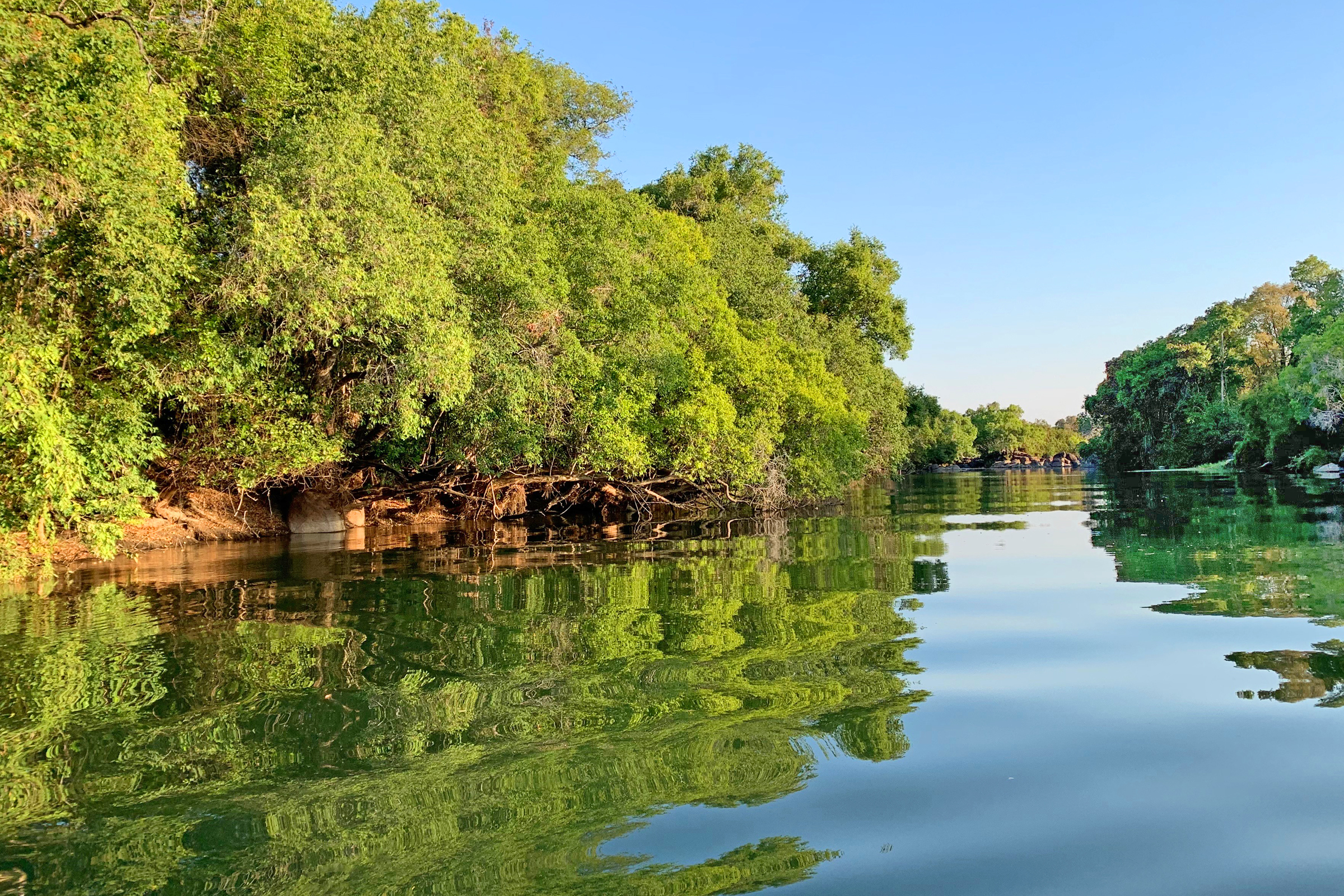
That river would be the Kafue, in west-central Zambia. A tributary of the more famous Zambezi River, the Kafue meanders for almost a thousand miles. Midway along, it intersects the enormous Kafue National Park, tracing the park’s eastern boundaries. The second-largest park in Africa, and one of the largest protected areas in the world, Kafue is home to elephant, lion, zebra, antelope, hundreds of bird species, and plenty of hungry, hungry hippos to mess with your sleep cycle.
Think “safari” and Zambia isn’t among the places that normally pop to mind. Kenya, Tanzania, and Botswana get most of the attention. They also get the crowds. Many African parks have come to feel more and more like zoos, replete with screaming kids and conga lines of minivans encircling some bewildered cheetah. It was the promise of a quieter and more secluded experience that drew me to Zambia, and to Kafue in particular.
Here you’ll find 8,600 square miles of unspoiled wilderness. Lush swaths of greenery skirt the riverbanks, then give way to endless expanses of the semi-deciduous woods known locally as “miambo.” Sun-baked plains of scrub and thorn are studded by century-old termite mounds; Baobab and fig trees soar in prehistoric-looking clusters. It’s as beautiful as it is hostile, but either way offering some of the most spectacular vistas you’ll ever see. Tourists are here, but not many. On a game drive you’re more likely to encounter an elephant than a Land Rover.
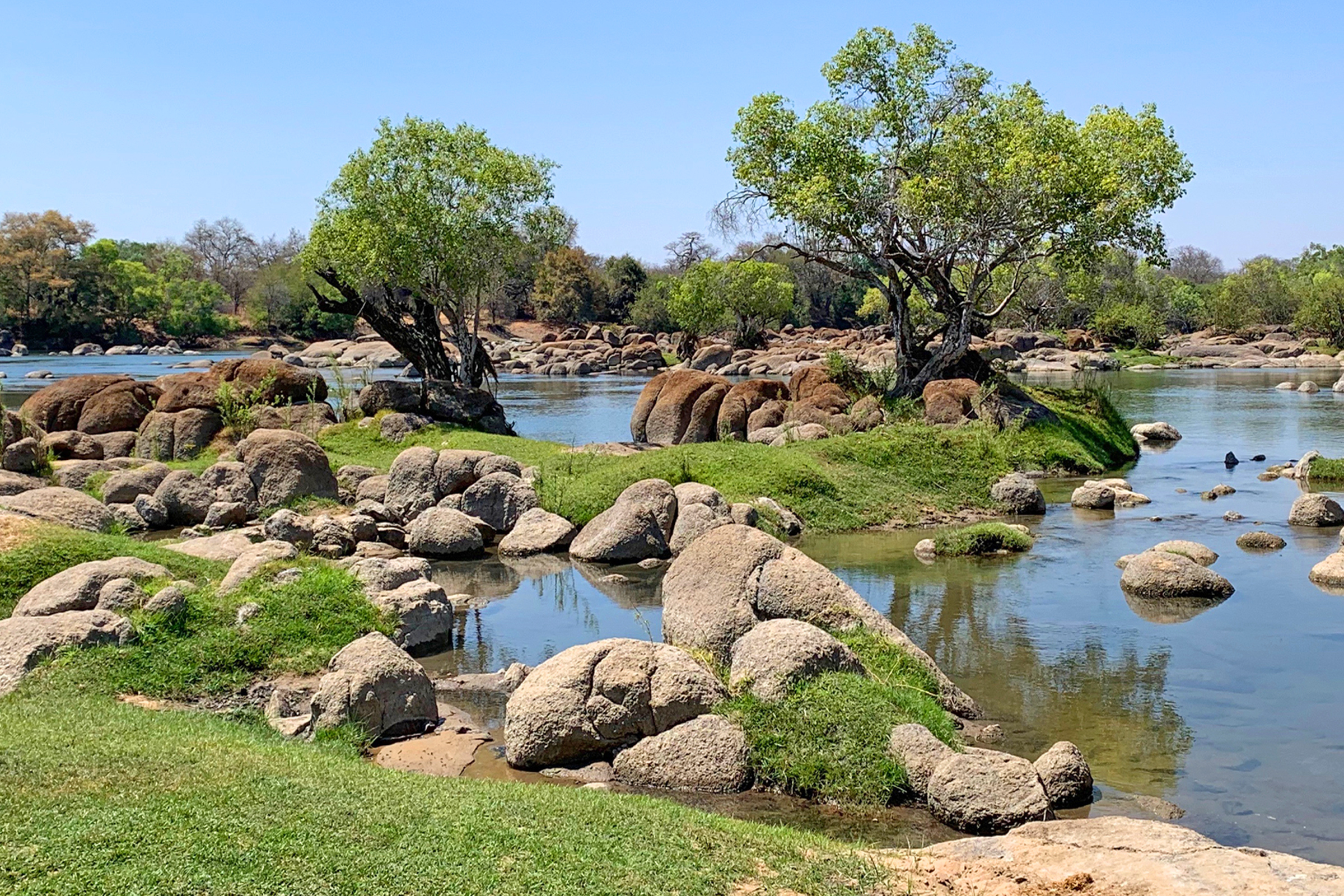
Of course, as much I appreciate remoteness and solitude, I’m also a sucker for creature comforts and letting someone else arrange the logistics of what to see, when to see it and how. That’s where the Kaingu Safari Lodge comes in. Five hours by road from the Zambian capital of Lusaka, or six from the southern frontier town of Livingstone, Kaingu is the most idyllically set of the Kafue game lodges. It’s right on the river, with six tented chalets, a “family” chalet with space for eight guests, and three campsites.
Kaingu was established in 2005 by Rick and Lynda Schultz, a pair of globe-trotting Australians from Melbourne. They were joined six years ago by Gil and Julia Dixon, by way of Scotland and Germany respectively. The two couples oversee a staff of up to 22 employees, including two chefs and a team of guides.
Kaingu deftly navigates the sometimes uneasy line between luxury and adventure. There’s that phrase, “white tablecloth safari,” with its colonialist overtones and 19th-century style affectations. That’s not Kaingu. Instead, you get just the right blend of rustic and indulgent. It’s not inexpensive, but neither is it extravagant or pretentious. “Bush boutique,” is how Julia Dixon describes it. The tented chalets, with thatched roofs and walled-in outdoor showers, are stylish but unfussy. Each overlooks the river, with a porch and chairs for that golden hour gin and tonic. Just remember to latch the screen door any time you step away. The resident vervet monkeys are as dastardly as they are amusing, and are liable to run off with your passport or binoculars.
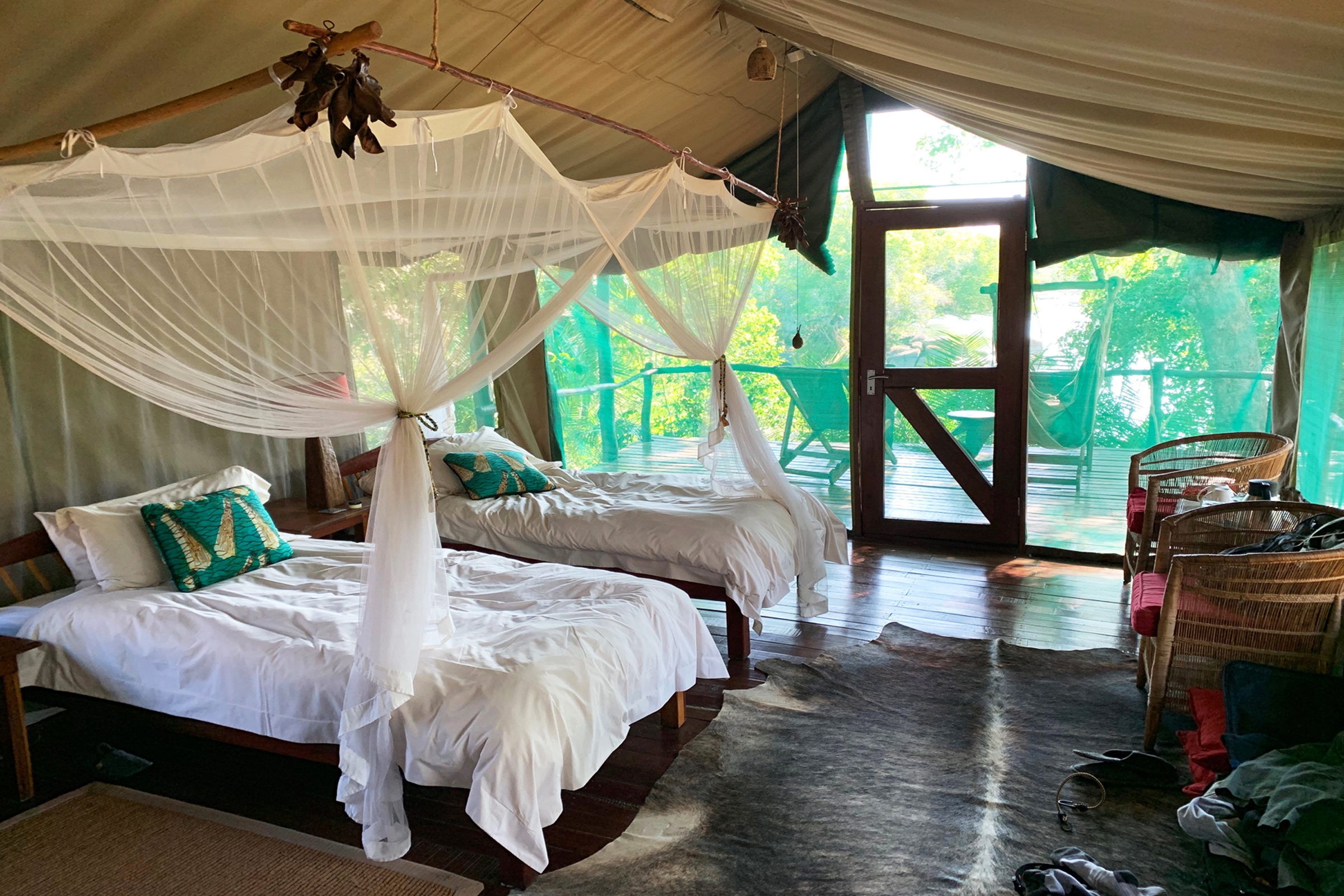
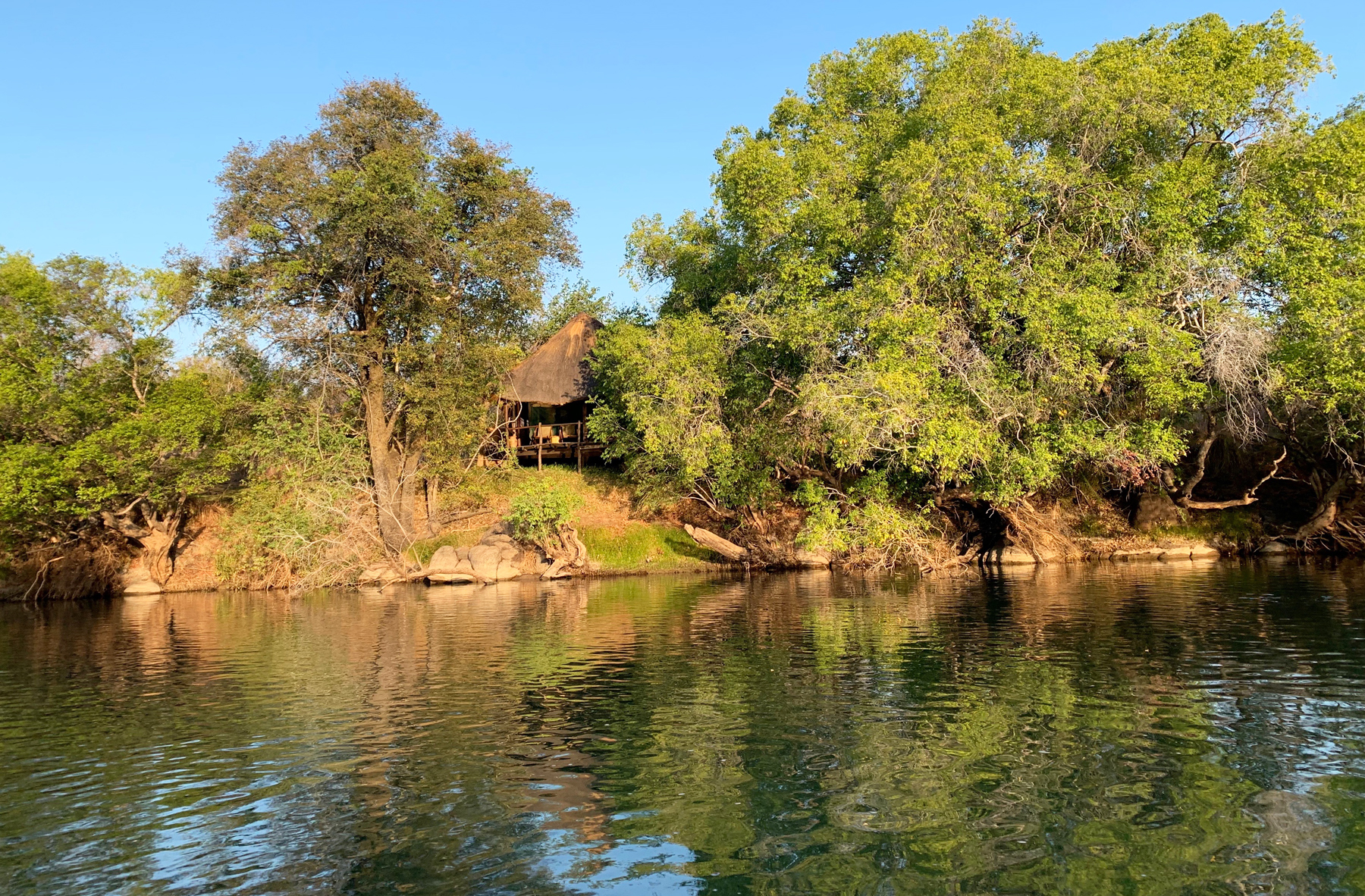
Kaingu’s outstanding pair of chefs, Wina and Elizabeth, prepare thrice-daily meals as good or better than anywhere in the country. I’m the ultimate non-foodie, yet there I was jumping with anticipation at the sound of the dinner bell (there is, literally, a bell). Every appetizer and entree, without exception, left me in a state of blissful satisfaction. One night it was the Kafue River crayfish with smoked tomato risotto and snow peas. The next it was lamb chops with ginger and almond sauce. Fish curry with cucumber lime salad? Seared breast of duck with glazed sweet potatoes? Hundreds of miles from the nearest big city, and I’ve never eaten so good. The ingredients are grown at the lodge or otherwise locally sourced, and everything — even the bread — is cooked on site.
Guests are assigned a guide, in whose company you can enjoy any of several partial or full-day activities, from game drives and treks to excursions along the river. The lodge has three aluminum outboards, each with seats for six. Overnight stays are available on nearby islands.
Our guide was the curiously named John Deere. We took this to be a humorous coincidence until John explained that Zambian children are often named in honor of material objects of meaning to their families. In this case, yes, a venerable tractor that had been a fixture on the family farm. John Deere turned out to be the most startlingly knowledgable nature guide I’ve met in over thirty years of travel. In an instant he could identify and describe virtually any of the park’s flora or fauna, be it a tree, a bird or a mammal. Some of these were the sort of marquee stars that needed no introduction (elephant, zebra, warthog, hippo), but without John, we wouldn’t have known a bushbuck from a waterbuck from a reedbuck; a grysbok from a hartebeest from a kudu.
He was particularly helpful when it came to birds. After a pair of full-day game drives I had logged close to 90 species, including several I’d never seen before, like the schalow’s turaco and the red chested cuckoo. The majority of these, if not for John’s keen eye and expertise, would have gone onto my life list accompanied by question marks or asterisks.
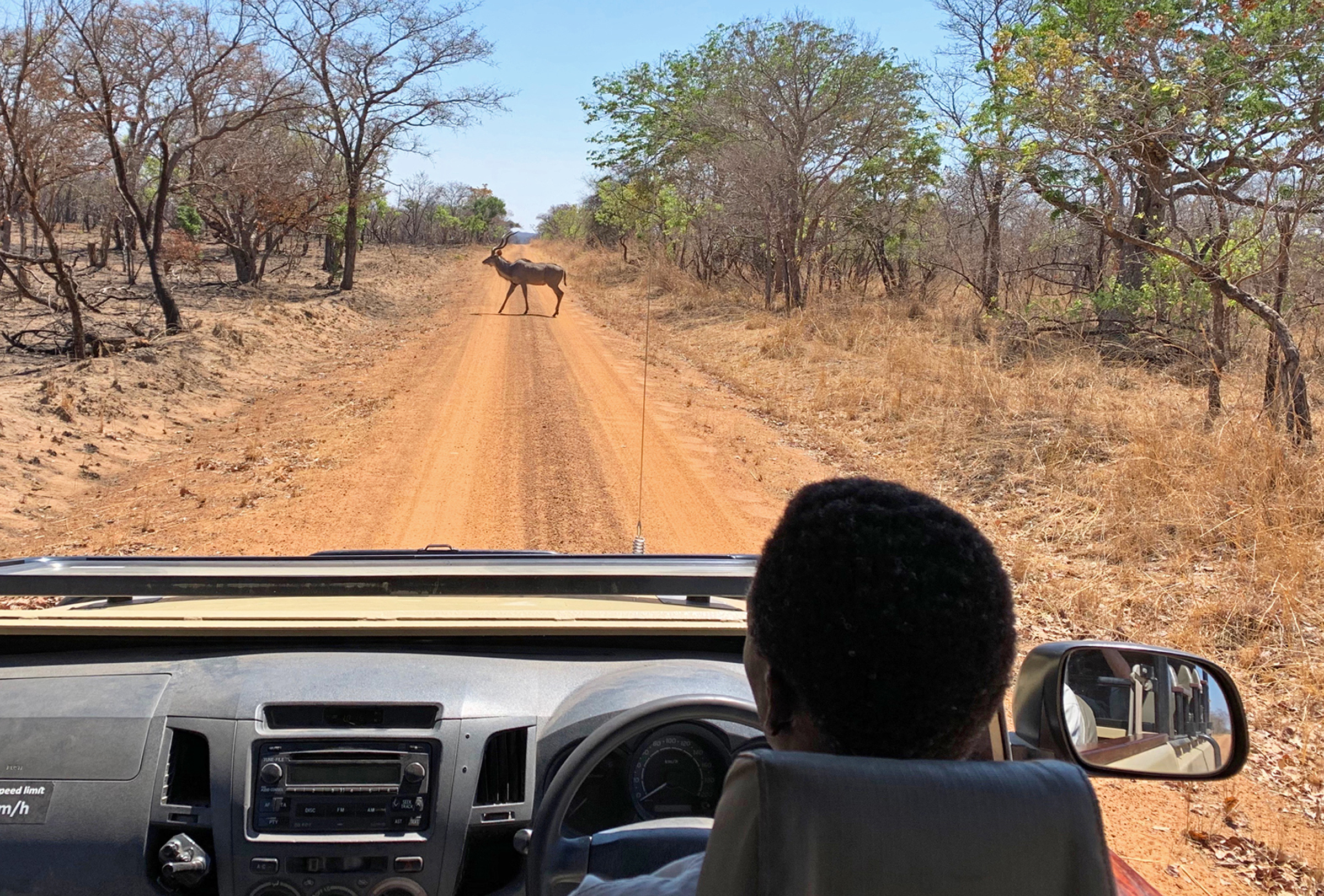
In the dry season, water levels in the Kafue drop substantially, revealing strings of almost comically picturesque islets. Soft sandy beaches are backdropped by stacks of enormous boulders buffed smooth and white after millennia of erosion. Beneath the boulders grow lawns of brilliantly green grass, strangely manicured to a perfect 3/4 inch, as if by machine. Thus each islet looks uncannily like a primordial miniature golf course, complete with rock sculptures and putting greens.
I was standing in the center of one of these putting greens when, to my consternation, John Deere matter of factly explained that the “machine” responsible for keeping the grass so neatly trimmed is, of course, the hippopotamus. I’d been dealing with enough hippo-related anxiety as it was, and didn’t need to hear this. We’d seen several hippo pods during the boat ride over, and I knew they were lurking nearby.
That anxiety would reach a crescendo 24 hours later:
It was our final afternoon, and the plan was to take a trip down the Kafue in inflatable kayaks. Whose idea this was I can’t remember, but I spent the morning dreading it, wracked by premonitions of being impaled on a hippo tusk and dragged to my demise. John Deere and Gil Dixon did their best to assuage my worries, employing such non-encouragements as, “It’s not likely to be dangerous.”
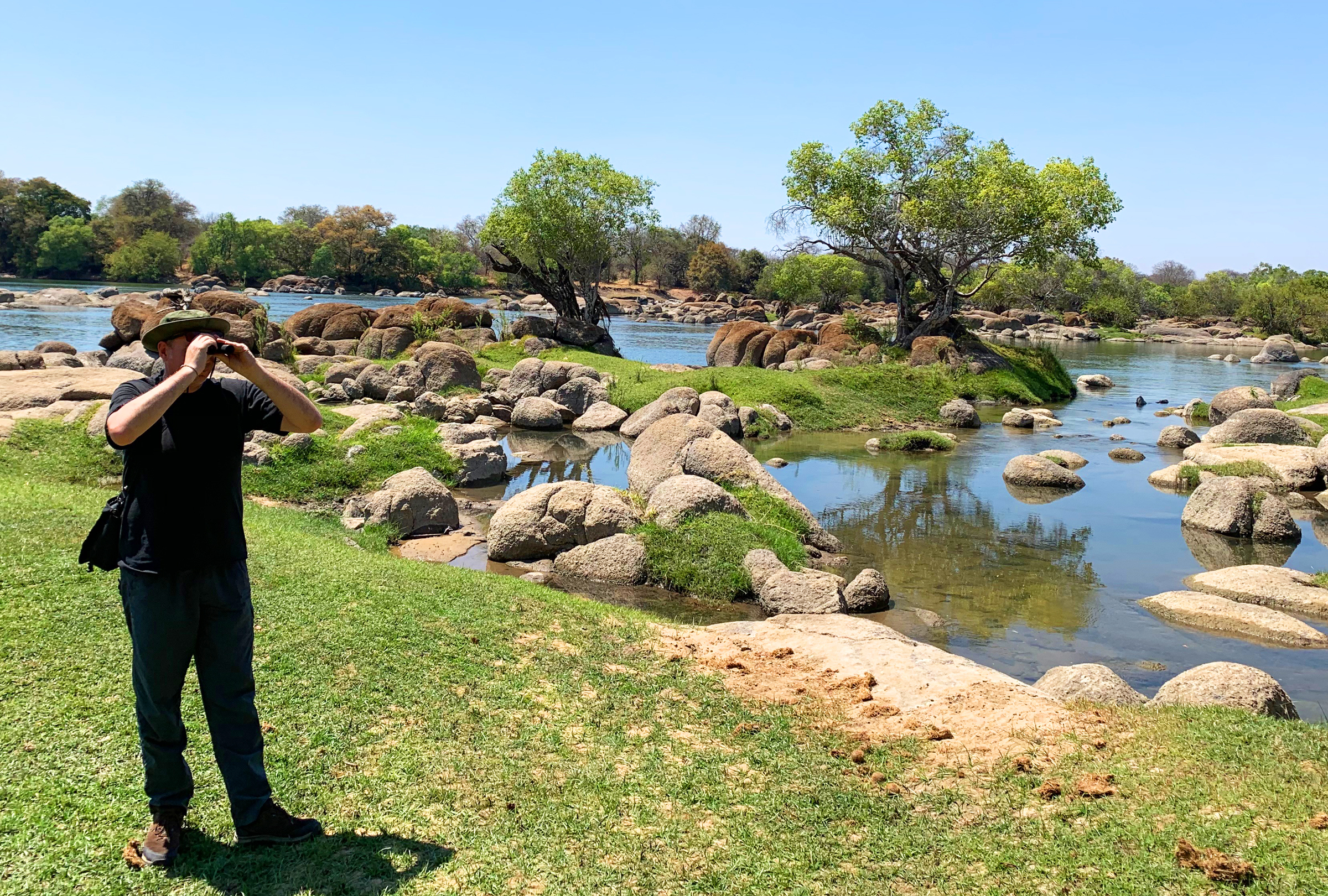
“But a hippo can chomp through metal,” I protested. “A golden retriever can sink an inflatable kayak.”
“You’ll be fine,” promised John. “If we do see a hippo anywhere close, just turn 90 degrees and paddle to the bank.”
We weren’t five minutes into the river when exactly that scenario happened. We’d entered a small channel alongside one of those cartoon islets when, right there, not thirty feet in front of me, I saw the hippopotamus, its ears wriggling adorably in that way you see in nature documentaries. It turned directly towards us, then ducked under.
“Hippo!” I yelled, digging in my paddle with an energy I’m scarcely capable of, yawing us hard toward the shore.
A few minutes later we were standing in the mud, waiting for a rescue boat. I refused to go any further.
That evening, on the veranda overlooking the river, Gil handed me a cocktail. “You know,” he said. “That hippo, it was just minding its business. I doubt it posed a threat.” He sighed. “But I guess I can’t blame you.” He then went on to entertain me — which is to say embarrass me — with tales of other guests whose bravado and derring-do made me feel like the biggest coward in Africa. Like the swaggering foursome of Aussies who took to the river in inner tubes, armed with only a pocket knife and a broomstick. They survived, and I would have too.
But heck, it wouldn’t have been a safari without a dose or two of fright. Even if most of it was self-induced.
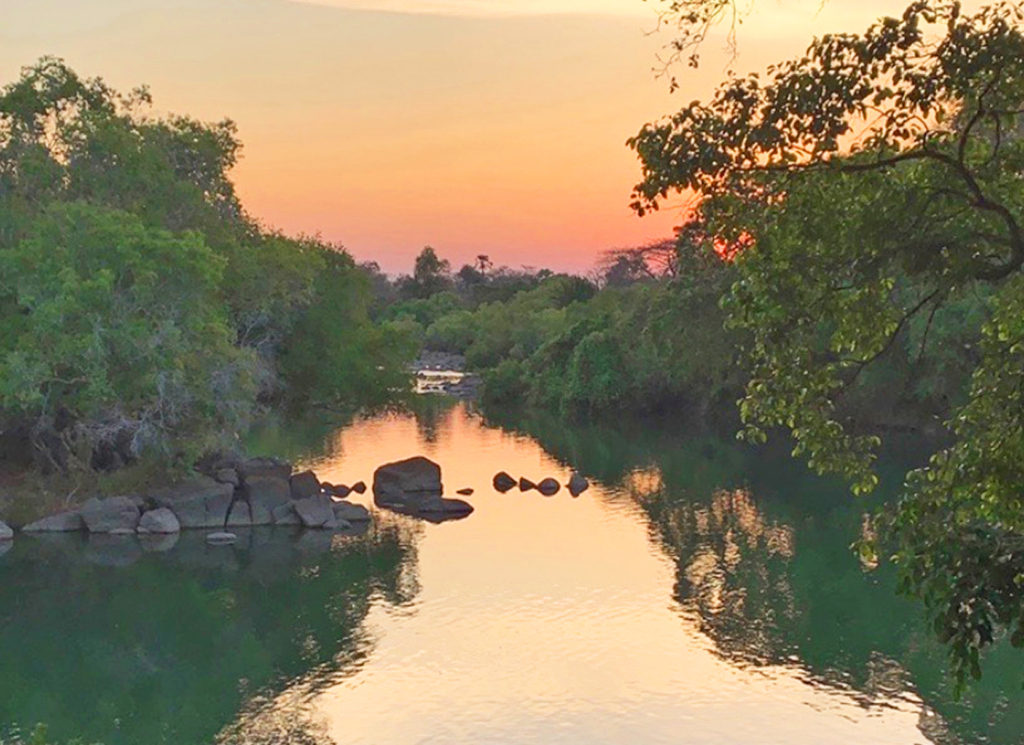
This story was originally published in 2020 in the Boston Globe.
![]()



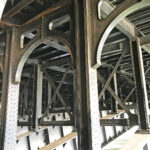

Leave a Comment
Maximum 1500 characters. Watch your spelling and grammar. Poorly written posts will be deleted!
10 Responses to “Bush Boutique”
You are viewing newest comments first. Click to reverse order
Nice story, Cap. Not one word from ATC, or an altitude, vector, fuel remaining, etc. Keep it up, please!
Patrick, your stories about the destinations you travel to are as fascinating as what you write about the technical & operational parts of air travel. I enjoyed this and look forward to more!
Thank you for the great story and the gorgeous photos, Patrick.
(I would never have boarded that kayak.)
I don’t know if anyone else has mentioned it, but you’re s damned good photographer.
Thanks. My greatest hits are organized here…
https://www.flickr.com/photos/globetrodden/albums
A nature-freak & old Africa-hand of my acquaintance says that hippos are a leading cause of death by accident in Africa. They haunt lakes & rivers, as their name suggests, often beneath the surface. People (& there are many) underway in boats can suddenly find themselves dumped into the water by surfacing hippos, often with fatal results.
Excellent review – you acquitted yrself nicely! I am mostly familiar with Kenya but this river view camp sounds terrific.
Laughed out loud about the river hippo. When you are in the safety biz it is sometimes easy to forget that other folks are safety experts in their lanes. Just summon your inner Anthony Bourdain.
Stay cool Patrick!
I still don’t know what these travelers do when mosquitoes get trapped inside the the mosquito netting.
Your hippo adventure reminds me of a nervous airline passenger.
Patrick, pick up your clothes off the floor before taking a photo of your hotel room!
Just kidding, the article is great.